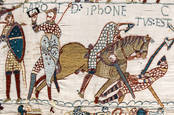Navy names new attack sub HMS Agincourt
The Royal Navy, always keeping up with the times, has named its newest attack submarine HMS Agincourt, after the 1415 battle where an English army beat French troops led by its nobility.
Agincourt the boat is the seventh and final Astute-class attack sub. The nuclear-powered vessels are used primarily to defend British interests from underwater, including seeing off marauding Russian vessels near British waters and also for sneaky-beaky missions of their own into foreign waters.
The £1.5bn submarine is under construction at BAE Systems’ yard in Barrow-in-Furness, Cumbria. Defence equipment minister Guto Bebb joyously declared: “Today’s announcement includes a £60m contract for Rolls-Royce, supporting over 700 jobs here in Derby as the factory continues to make the reactors that will power our state-of-the-art Dreadnought subs into the 2060s.”
While naval-gazers had enthusiastically discussed rumours that the seventh Astute boat might fall victim to defence cuts, rumours fed by an increasingly ominous silence from the Ministry of Defence, a scoop by defence trade news website Shephard confirmed that construction was indeed going ahead, the contract having been signed back in March.
All of the Astute class are fitted with the BAE Systems-developed Core Combat System, which runs on VMware and Dell hardware inside the boat as a “miniature data centre”.
The name Agincourt is mildly controversial, inasmuch as it brings to mind the famous victory of King Henry V over France at a time where the English army, which was blundering around the Pas-de-Calais countryside, was largely thought to be on its last legs and cut off from its chances to retreat back home. In the words of the king’s (fictional, thanks to Shakespeare) eve-of-battle speech, it was “we few, we happy few, we band of brothers” up against the very best France had to offer.
Through “yew bow and cloth yard shaft”, as the chroniclers of the day put it, the English and Welsh longbowmen shot a torrent of arrows into the heavily armoured French knights. The arrows’ steel points penetrated the plate armour of the French nobles and the lightly equipped English then set about the bogged-in Frenchmen, whose weighty suits of armour were totally unsuited to the heavy mud of the battlefield.
In today’s world, where the UK and France are close allies and England has given way to the United Kingdom, naming the submarine Agincourt may be seen by some as a bit of an unintentional snub, bringing to mind Henry V’s slaughter of French prisoners of war and the failed negotiations that preceded the battle over Henry’s disputed claim to the title of King of France.
Though the name has historical connotations of success for England, its Royal Navy history is rather more chequered. Five ships of the fleet have been named Agincourt throughout the centuries, most recently a Second World War-era destroyer converted to carry one of the Navy’s first anti-aircraft guided missile systems, as well as a First World War dreadnought battleship seized by the British government from the Ottoman Empire at the war’s outbreak – an act that seriously hacked off Turkey, not least because it had paid for the ship in full and was awaiting her delivery.
Agincourt will take her place in the fleet alongside sister sub HMS Artful – which brings to mind the Artful Dodger, a pickpocket in Charles Dickens’ novel Oliver Twist. ®
Sponsored: Minds Mastering Machines – Call for papers now open
READ MORE HERE

